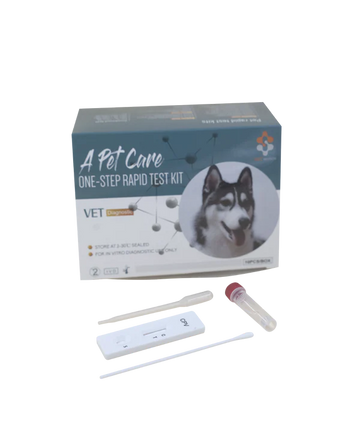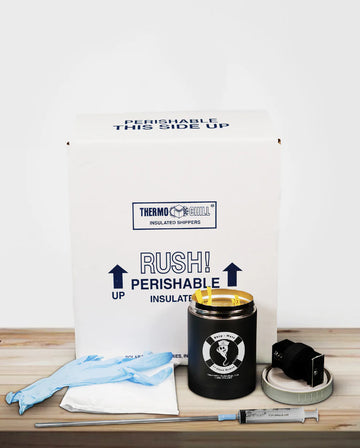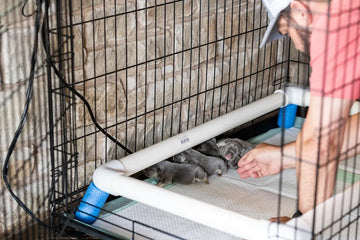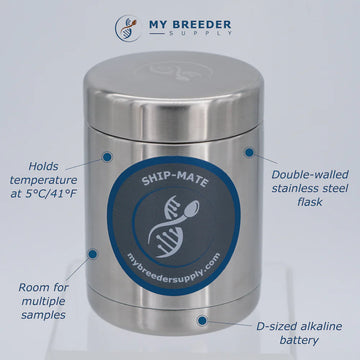
Introduction to Parvovirus in Dogs
Canine parvovirus, commonly known as parvo, is a highly contagious viral infection that affects dogs, particularly puppies. The virus attacks a dog's gastrointestinal tract, causing severe vomiting, diarrhea, and dehydration, which can be life-threatening if not treated promptly.
Importance of Early Detection
Detecting parvo early is crucial for successful treatment and recovery. The sooner the virus is identified, the better the chances of your dog receiving appropriate care and recovering from the infection. This is where at-home parvo tests come in handy, allowing pet owners to test their dogs in the comfort of their own homes and take swift action if needed.
Understanding At-Home Parvo Tests

How Do At-Home Parvo Tests Work?
At-home parvo tests typically come in two forms: swab tests and blood tests.
Swab Test
The swab test involves taking a sample from your dog's rectum using a swab provided in the test kit. This sample is then mixed with a solution and added to a testing device, which will display the results after a short period.
Blood Test
The blood test requires a small blood sample from your dog, which is then mixed with a reagent and added to the testing device. Similar to the swab test, results will be displayed after a few minutes.
Pros and Cons of At-Home Parvo Testing
While at-home parvo tests offer convenience and quick results, they also have some drawbacks. They may not be as accurate as tests conducted by a veterinarian, and false negatives or positives can occur. However, they can still be a useful tool for early detection and determining when a visit to the vet is necessary.
Choosing the Right At-Home Parvo Test

Factors to Consider When Selecting a Test
When selecting an at-home parvo test, consider the following factors:
- Accuracy: Look for tests with high accuracy rates to minimize false results.
- Ease of use: Choose a test that is easy to administer and has clear instructions.
- Price: Consider your budget, but remember that quality is essential when it comes to your dog's health.
Top At-Home Parvo Test Kits
Here are some of the top at-home parvo test kits available on the market:
- Snap Parvo Test by IDEXX: This test is known for its accuracy and ease of use. It uses a blood sample to quickly detect the presence of parvovirus.
- WITNESS Parvo Test by Zoetis: Another reliable option, this test uses a swab sample and provides results in just 10 minutes.
- Anigen Rapid Parvo Test by BioNote: This test kit is also user-friendly and can detect the virus in both blood and fecal samples.
Conducting the At-Home Parvo Test

Step-by-Step Guide to Testing
Follow these steps to conduct an at-home parvo test:
- Read the instructions provided with your chosen test kit carefully.
- Prepare your dog and the testing area. Ensure your dog is calm and the testing site is clean and well-lit.
- Collect the sample as directed, either by swabbing your dog's rectum or drawing blood.
- Add the sample to the testing device according to the kit's instructions.
- Wait for the specified time for the results to appear. This usually takes a few minutes.
- Read and interpret the results according to the test kit's guidelines.
Interpreting Test Results
Each test kit will have its own method for displaying results, so be sure to follow the instructions carefully. Generally, a positive result indicates the presence of the parvovirus, while a negative result suggests your dog is not currently infected. However, keep in mind that false results can occur, so it's important to consult your veterinarian for confirmation and further testing.
What to Do if Your Dog Tests Positive for Parvo
Immediate Steps to Take
If your dog tests positive for parvo, take the following steps:
- Contact your veterinarian immediately to discuss the results and plan appropriate treatment.
- Isolate your dog from other pets to prevent the spread of the virus.
- Keep your dog hydrated and monitor their condition closely.
- Treatment Options and Recovery
Parvo treatment typically involves supportive care, such as:
- Intravenous fluids to combat dehydration
- Anti-nausea medications to reduce vomiting
- Antibiotics to prevent secondary infections
- Nutritional support to help your dog regain strength
With prompt and appropriate treatment, many dogs can recover from parvo. However, it is essential to follow your veterinarian's advice and continue monitoring your dog's condition throughout the recovery process.
My Breeder Supply: A Trusted Resource for At-Home Parvo Tests

When it comes to purchasing at-home parvo tests, it's essential to choose a reputable supplier to ensure the quality and accuracy of the test kits. My Breeder Supply is a trusted resource for dog breeders, pet owners, and animal care professionals, offering a wide range of high-quality products, including at-home parvo tests.
Why Choose My Breeder Supply for At-Home Parvo Tests?
There are several reasons why My Breeder Supply stands out as a reliable provider of at-home parvo tests:
Quality Products: My Breeder Supply offers only top-rated parvo test kits from reputable manufacturers, ensuring that customers receive accurate and reliable tests.
Expert Advice: The team at My Breeder Supply is knowledgeable and experienced in the field of canine health, ensuring that customers receive expert advice and guidance when selecting the right test kit for their needs.
Competitive Pricing: My Breeder Supply offers competitive pricing on all of its products, including at-home parvo tests, so customers can access high-quality tests without breaking the bank.
Fast Shipping: My Breeder Supply understands the importance of early detection and prompt treatment for parvo, which is why they prioritize fast shipping and delivery of their products.
Customer Support: My Breeder Supply's dedicated customer support team is available to assist customers with any questions or concerns they may have about their purchases, providing a seamless shopping experience.
At-home parvo tests can be a valuable tool for early detection of the virus and ensuring your dog receives timely treatment. By understanding the different types of tests available, selecting a reliable test kit, and following the proper testing procedure, you can help protect your dog's health and well-being. Always consult your veterinarian if you have concerns about your dog's health or if your dog tests positive for parvo.
Frequently Asked Questions About At-Home Parvo Tests
How accurate are at-home parvo tests?
At-home parvo tests vary in accuracy, with some tests offering higher accuracy rates than others. While they may not be as accurate as tests conducted by a veterinarian, they can still serve as a useful tool for early detection.
Can my dog be re-infected with parvo after recovery?
It is rare for a dog to be re-infected with parvo after recovering, as they typically develop immunity to the virus. However, maintaining a clean environment and ensuring your dog is up-to-date on vaccinations is essential for continued protection.
How long does it take for a dog to recover from parvo?
The recovery time for a dog with parvo varies depending on the severity of the infection and the effectiveness of the treatment. Generally, recovery can take anywhere from one to three weeks, with some dogs requiring additional time to regain their strength and overall health.
How can I prevent my dog from contracting parvo?
The best way to prevent your dog from contracting parvo is through proper vaccination. Puppies should receive a series of vaccinations starting at around six weeks of age, with booster shots administered as recommended by your veterinarian. Additionally, maintaining a clean environment and avoiding contact with infected dogs can help reduce the risk of infection.
Can humans catch parvo from dogs?
Canine parvovirus is not contagious to humans. However, humans can inadvertently spread the virus between dogs, as the virus can survive on surfaces and objects for extended periods. It's essential to practice good hygiene and clean up after your dog to minimize the spread of the virus.




